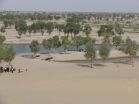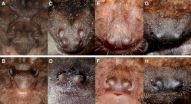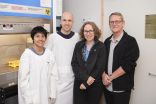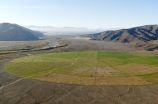Last chance for oasis in China's desert
Sustainable oasis management in China's largest cotton-growing region
2015-09-09
(Press-News.org) This news release is available in German.
Ten percent of the world's cotton is produced in the Xinjiang region in northwestern China. Irrigating the cotton fields, however, is causing ecological problems. After many years of research, a team of international researchers headed by Prof. Markus Disse at the Technical University of Munich (TUM) has developed a set of recommendations aimed at preserving the local environment.
The Tarim basin in the Xinjiang region of northwestern China is unique. No other natural landscape is located as far from the ocean. It has an extremely dry climate with only around 50 millimeters of rain falling per square kilometer each year - and the majority of this evaporates. Despite these conditions, the Tarim river flows through this desert region, mainly fed by meltwater from high-altitude glaciers.
This water is a vital resource for a number of groups including:
Around ten million people who live along the banks of the Tarim
Local animal and plant species
The land surrounding the river
Farmers, however, are diverting the lion's share of the water to irrigate their cotton fields. "The natural land and water resources in this unique landscape have been ruthlessly exploited over the past 50 years. This has severely damaged the soils and the quality of water in the region," explains Professor Markus Disse from the Chair of Hydrology and River Basin Management at TUM. As a result, the soils have become increasingly saline. And this is bad news for the farmers. Non-saline soils can support yields of up to eight tons of cotton per hectare whereas soils with medium to high levels of salt can only produce three to four tons per hectare.
Disse has headed the "Sustainable Management of River Oases along the Tarim River" (SuMaRiO) project since 2011. The initiative is funded by Germany's Federal Ministry of Education and Research (BMBF) and includes researchers from Germany and China.
Largest cotton producing region in China
"Cotton is the lifeblood of most farmers who live in the Tarim basin," says Dr. Christian Rumbaur, employee at the Chair of Hydrology and River Basin Management and coordinator of the German/Chinese project. Forty percent of China's cotton is produced here. This corresponds to around ten percent of global production.
The lack of rain is what makes the region suitable for cultivating this valuable plant. The cotton fibers need a dry climate to mature properly; in a damper environment, they would be susceptible to fungus. Yet the plants also need a lot of water to grow, and the farmers take this from the river.
Under these conditions, groundwater supplies cannot be regenerated. This is proving a threat to the Euphrates Poplar, which draws water from a depth of up to ten meters. Sixty to seventy percent of the world's population of this rare tree species are located in the Tarim basin. The forests act as a barrier against the sands from the neighboring Taklamakan desert. Without them, whole roads and fields would disappear under the advancing desert. The forests also help keep down temperatures through evaporation.
Despite these benefits, farmers are cutting down more and more poplars in order to enlarge their fields. Climate change is one of the factors driving this expansion. Snow on the glaciers is melting, causing more water to flow into valley, and this means more water for irrigation.
The fight against desertification
After years of measurements and investigation, the researchers will be presenting their findings at a conference in Xinjiang in September. They will also be unveiling their recommendations for improving water and land management.
The most important points here include:
Reforestation and renaturalization along a strip of land at least 50 to 100 meters wide along both banks of the river. This will allow the groundwater to be replenished during the annual summer flood and will also reduce erosion along the river banks.
Sustainable land use that factors in the different types of soil and their degree of salination. Cultivating the plant Apocynum pictum (a member of the dogbane family) on salinated soils will enable farmers to earn an income from poor soils.
Use of modeling tools to predict the impact of land use and climate scenarios. To this end, the SuMaRiO researchers developed a system that supports decision-making processes by enabling politicians to evaluate the consequences of different farming alternatives based on future changes in climate.
"We hope that this implementation workshop will herald a new era in sustainable land and water management in the region," adds Disse. "This is the only way that we can ensure long-term stability in this part of the world."
INFORMATION:
Download highresolution pictures: https://mediatum.ub.tum.de/?change_language=en
Contact:
Prof. Dr.-Ing. Markus Disse
Technical University of Munich
Chair of Hydrology and River Basin Management
Tel + 49.89.289.23916
email: markus.disse@tum.de
http://www.hydrologie.bgu.tum.de
Dr. Christian Rumbaur
Technical University of Munich
Chair of Hydrology and River Basin Management
Tel: +49 89 289 23227
email: christian.rumbaur@tum.de
[Attachments] See images for this press release:

ELSE PRESS RELEASES FROM THIS DATE:
2015-09-09
EVANSTON, Ill. --- In both blacks and whites, everyday feelings of discrimination can mess with the body's levels of the primary stress hormone, cortisol, new research suggests.
In African-Americans, however, the negative effects of perceived discrimination on cortisol are stronger than in whites, according to the study, one of the first to look at the biological response to the cumulative impact of prejudicial treatment.
The team of researchers, led by Northwestern University, also found that the teenage years are a particularly sensitive period to be experiencing ...
2015-09-09
Are black voters more likely to vote for black candidates, regardless of political party affiliation?
A new study by a University of Cincinnati researcher presents discouraging news for Republican leaders hoping to win over this Democratic stronghold by nominating black Republican candidates for political offices.
"There are some very successful African-American Republicans, but those folks don't attract African-American votes," said the study's author, David Niven, a University of Cincinnati professor of political science. "Party matters so much more than race."
In ...
2015-09-09
Michigan hospitals participating in the American College of Cardiology's "See You in 7" program demonstrated important reductions in 30-day readmission rates for Medicare heart failure patients when compared to non-participating hospitals despite only modest increases in seven-day follow-up appointments, according to a study today in JACC: Heart Failure.
"See You in 7" is part of the ACC's Hospital-to-Home initiative, a national quality improvement program aimed at reducing heart disease-related hospital readmissions and improving the transition from hospital to home. ...
2015-09-09
The barbastelle bat may emit two different types of weak echolocation signals alternately, one upward through the nose and one downward through the mouth, to find prey while undetected and to sufficiently keep track of the environment, respectively, according to a study published September 9, 2015 in the open-access journal PLOS ONE by Anna-Maria Seibert and colleagues from the University of Tübingen, Germany.
Barbastelle bats prey almost exclusively on eared moths, using "stealth echolocation" signals that are 10-100 times weaker than those of other aerial hawking ...
2015-09-09
Clinical trials for a dengue fever treatment could start within a year, following a discovery by University of Queensland scientists.
UQ's School of Chemistry and Molecular Biosciences Head Professor Paul Young said the researchers had identified similarities in how the body reacted to dengue virus and bacterial infections, in a finding that would allow them to re-purpose existing drugs.
"We have discovered that the dengue virus NS1 protein acts as a toxin in the body, in a similar manner to the way bacterial cell wall products lead to septic shock in bacterial infections," ...
2015-09-09
US fans of the National Football League (NFL) and sports reporters assigned to specific teams have unrealistic expectations about how well their team will perform, finds new research from UCL and Oxford University.
The study, published in PLOS ONE, also reveals which teams are most liked and disliked, as well as which teams have the most optimistic fans.
The main results are from an April 2015 survey of 1,116 US-based NFL fans, who were asked to predict how many games their favourite and least favourite teams would win in the 2015 season. As each team plays 16 games ...
2015-09-09
New research suggests that offering financial incentives for farming industries to mitigate the impact agriculture has on the environment, by reducing fertiliser use and 'sparing' land for conservation, for example, actually has a positive effect on critical areas such as greenhouse gas reduction and increased biodiversity.
It has been a point of contention whether such 'cash for conservation' initiatives succeed. For the latest study, researchers aggregated investment in environmental incentives at a national level for the first time, and, by comparing them to broad ...
2015-09-09
COLUMBUS, Ohio - A new study suggests that changes in immune function can occur as long as five years before the diagnosis of a brain tumor that typically produces symptoms only three months before it is detected.
Using blood samples collected an average of 15 years before brain tumor diagnosis to analyze interactions between 12 allergy-related proteins, researchers looked at how those relationships differed between people later diagnosed with brain tumors and cancer-free controls.
Among people who were subsequently diagnosed with this brain tumor, called a glioma, ...
2015-09-09
The Wilson Center's Science and Technology Innovation Program (STIP) is releasing a five-episode video series looking at the potential for additive manufacturing to transform how we build things - and what we need to do to fully realize this potential.
Beyond the Desktop explores how additive manufacturing could affect the fields of medicine, aerospace, space technology and more. Beginning Sept. 9, 2015, a new episode will be released each Wednesday through early October. Episodes will be posted on the Wilson Center homepage: https://www.wilsoncenter.org/3dprinting
Many ...
2015-09-09
Researchers have shown for the first time that phytoplankton (plant life) in remote ocean regions can contribute to rare airborne particles that trigger ice formation in clouds. Results published this week (Wednesday 9 September) in the journal Nature show that the organic waste from life in the oceans, which is ejected into the atmosphere along with sea spray from breaking waves, stimulates cloud droplets to freeze into ice particles. This affects how clouds behave and influence global climate, which is important for improved projections of future climate change.
Clouds ...
LAST 30 PRESS RELEASES:
[Press-News.org] Last chance for oasis in China's desert
Sustainable oasis management in China's largest cotton-growing region



